EDUCATIONAL TECHNOLOGY FOR THE INCLUSIVE CLASSROOM
VerifiedAdded on 2022/08/26
|11
|2503
|20
AI Summary
Contribute Materials
Your contribution can guide someone’s learning journey. Share your
documents today.
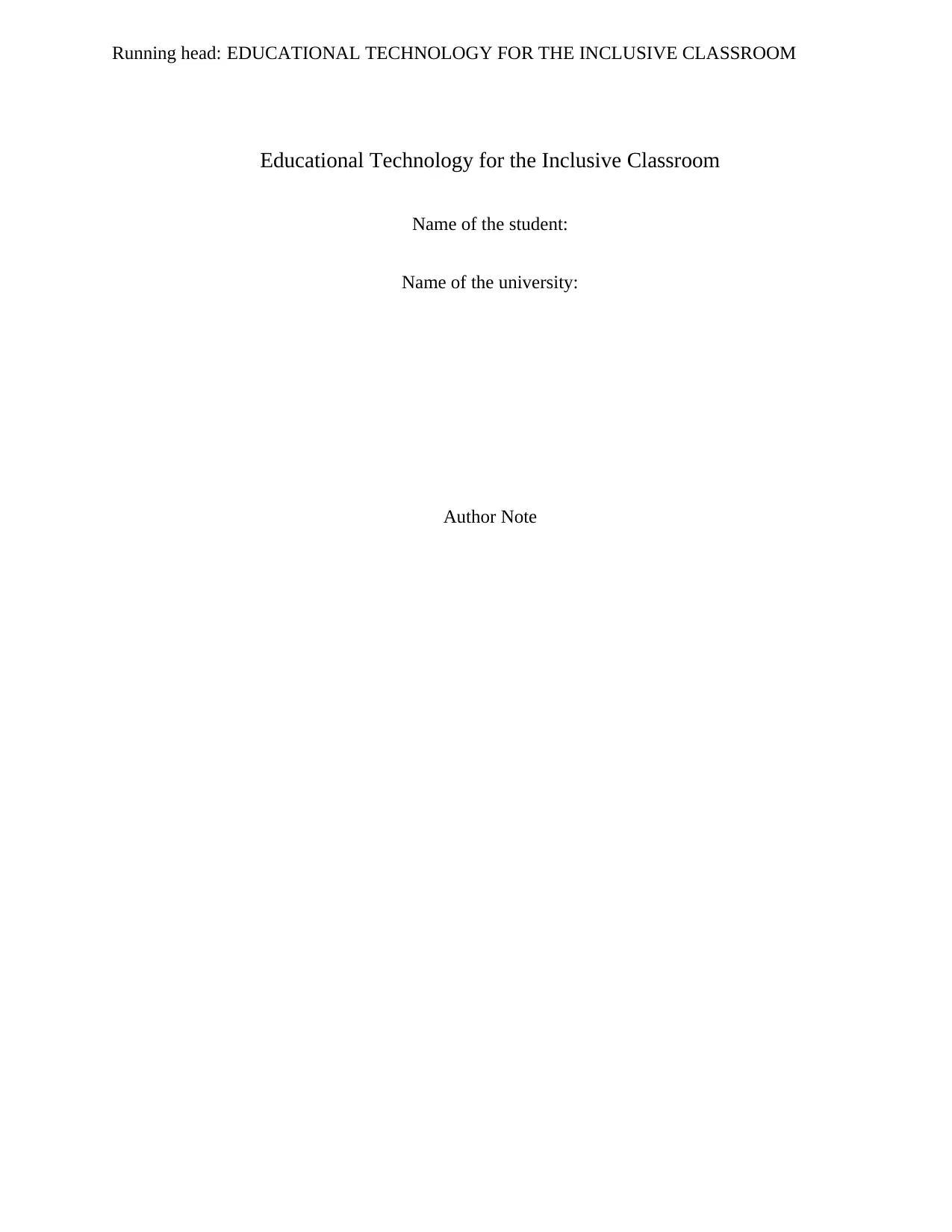
Running head: EDUCATIONAL TECHNOLOGY FOR THE INCLUSIVE CLASSROOM
Educational Technology for the Inclusive Classroom
Name of the student:
Name of the university:
Author Note
Educational Technology for the Inclusive Classroom
Name of the student:
Name of the university:
Author Note
Secure Best Marks with AI Grader
Need help grading? Try our AI Grader for instant feedback on your assignments.
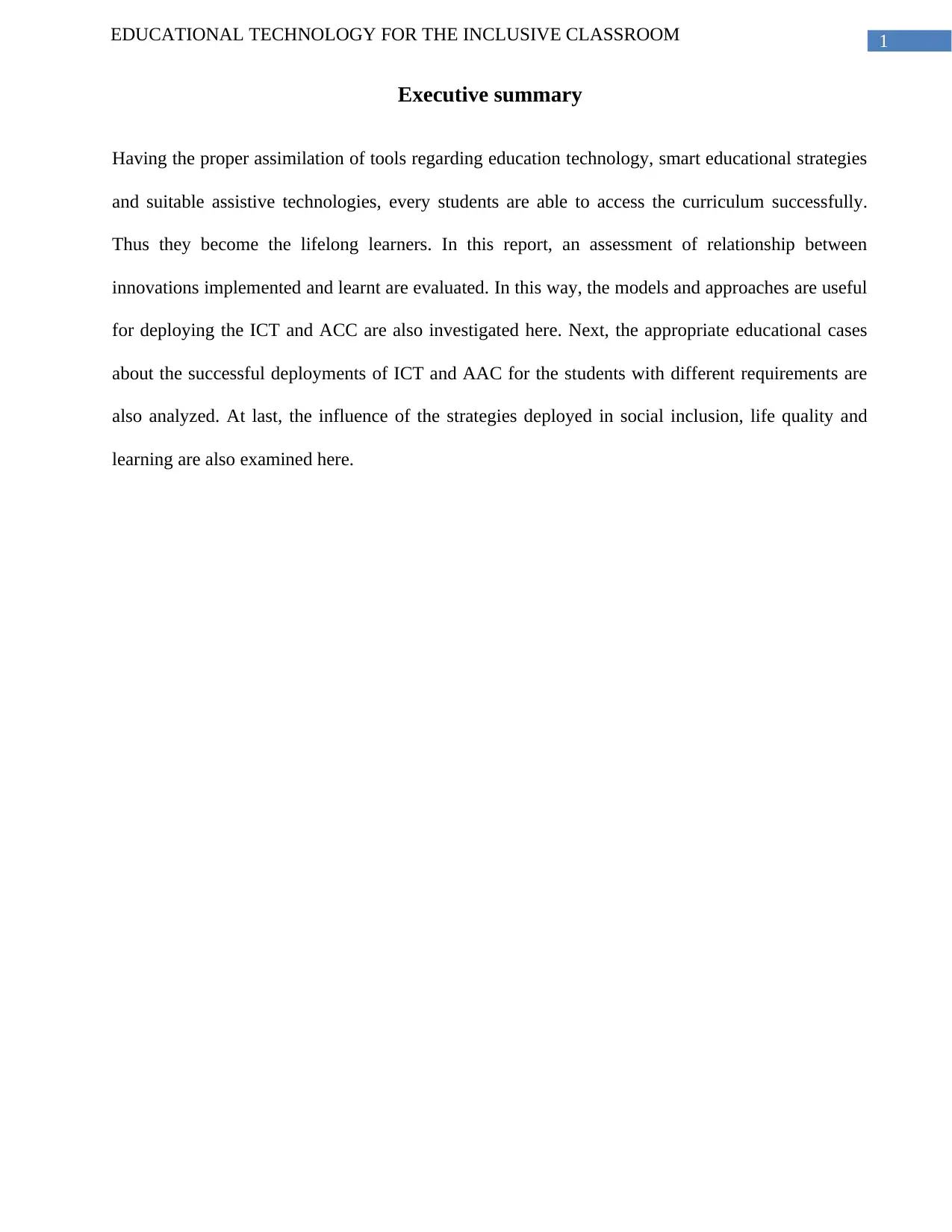
1EDUCATIONAL TECHNOLOGY FOR THE INCLUSIVE CLASSROOM
Executive summary
Having the proper assimilation of tools regarding education technology, smart educational strategies
and suitable assistive technologies, every students are able to access the curriculum successfully.
Thus they become the lifelong learners. In this report, an assessment of relationship between
innovations implemented and learnt are evaluated. In this way, the models and approaches are useful
for deploying the ICT and ACC are also investigated here. Next, the appropriate educational cases
about the successful deployments of ICT and AAC for the students with different requirements are
also analyzed. At last, the influence of the strategies deployed in social inclusion, life quality and
learning are also examined here.
Executive summary
Having the proper assimilation of tools regarding education technology, smart educational strategies
and suitable assistive technologies, every students are able to access the curriculum successfully.
Thus they become the lifelong learners. In this report, an assessment of relationship between
innovations implemented and learnt are evaluated. In this way, the models and approaches are useful
for deploying the ICT and ACC are also investigated here. Next, the appropriate educational cases
about the successful deployments of ICT and AAC for the students with different requirements are
also analyzed. At last, the influence of the strategies deployed in social inclusion, life quality and
learning are also examined here.
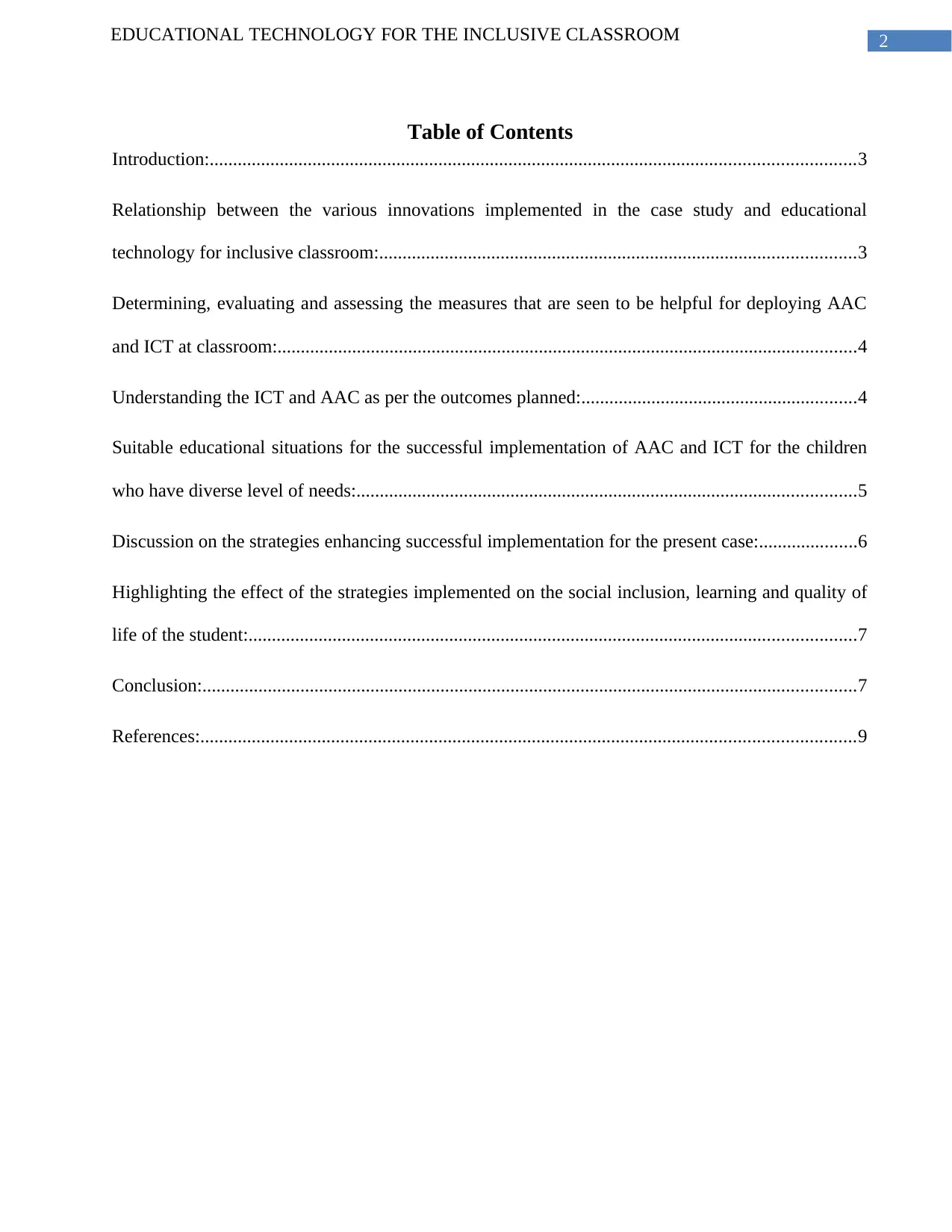
2EDUCATIONAL TECHNOLOGY FOR THE INCLUSIVE CLASSROOM
Table of Contents
Introduction:..........................................................................................................................................3
Relationship between the various innovations implemented in the case study and educational
technology for inclusive classroom:......................................................................................................3
Determining, evaluating and assessing the measures that are seen to be helpful for deploying AAC
and ICT at classroom:............................................................................................................................4
Understanding the ICT and AAC as per the outcomes planned:...........................................................4
Suitable educational situations for the successful implementation of AAC and ICT for the children
who have diverse level of needs:...........................................................................................................5
Discussion on the strategies enhancing successful implementation for the present case:.....................6
Highlighting the effect of the strategies implemented on the social inclusion, learning and quality of
life of the student:..................................................................................................................................7
Conclusion:............................................................................................................................................7
References:............................................................................................................................................9
Table of Contents
Introduction:..........................................................................................................................................3
Relationship between the various innovations implemented in the case study and educational
technology for inclusive classroom:......................................................................................................3
Determining, evaluating and assessing the measures that are seen to be helpful for deploying AAC
and ICT at classroom:............................................................................................................................4
Understanding the ICT and AAC as per the outcomes planned:...........................................................4
Suitable educational situations for the successful implementation of AAC and ICT for the children
who have diverse level of needs:...........................................................................................................5
Discussion on the strategies enhancing successful implementation for the present case:.....................6
Highlighting the effect of the strategies implemented on the social inclusion, learning and quality of
life of the student:..................................................................................................................................7
Conclusion:............................................................................................................................................7
References:............................................................................................................................................9
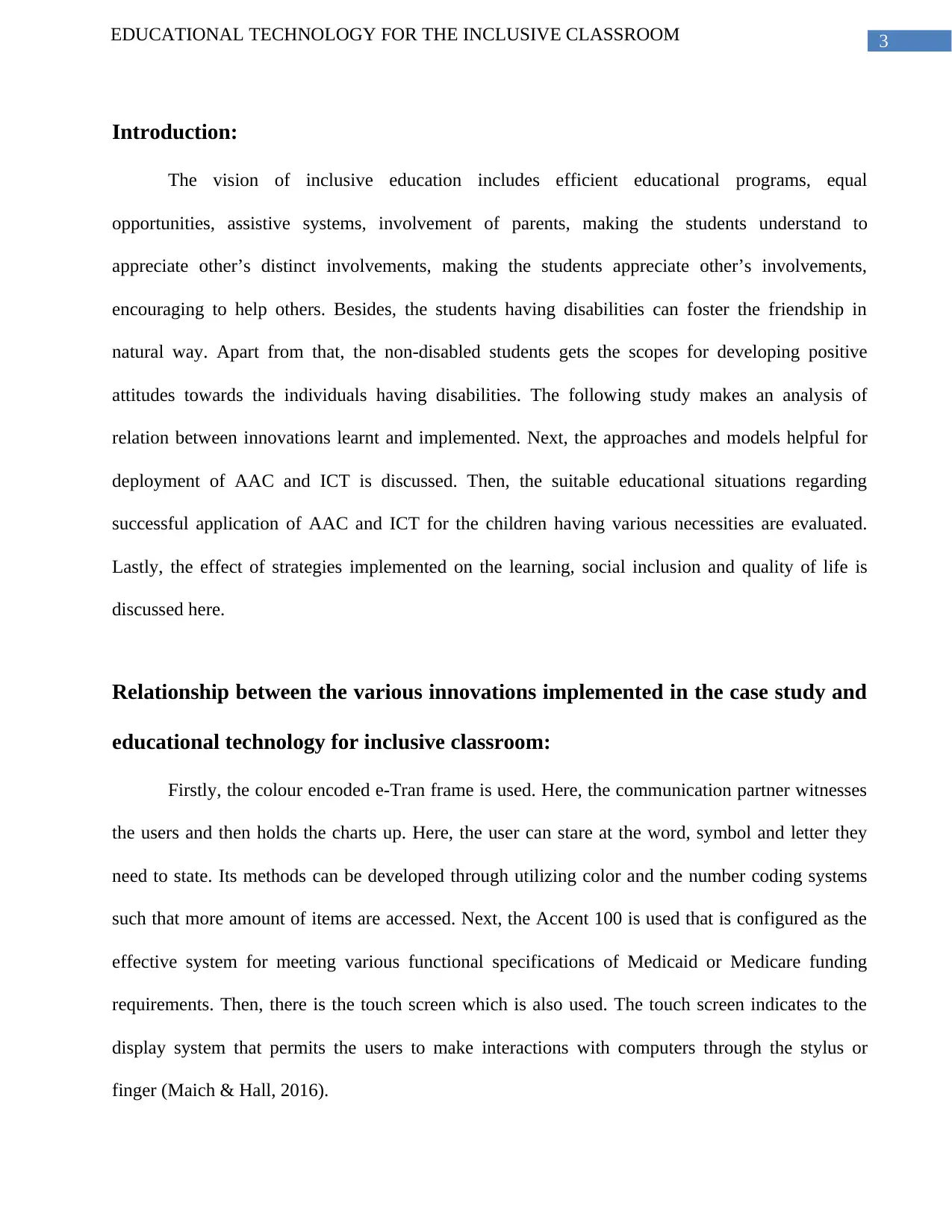
3EDUCATIONAL TECHNOLOGY FOR THE INCLUSIVE CLASSROOM
Introduction:
The vision of inclusive education includes efficient educational programs, equal
opportunities, assistive systems, involvement of parents, making the students understand to
appreciate other’s distinct involvements, making the students appreciate other’s involvements,
encouraging to help others. Besides, the students having disabilities can foster the friendship in
natural way. Apart from that, the non-disabled students gets the scopes for developing positive
attitudes towards the individuals having disabilities. The following study makes an analysis of
relation between innovations learnt and implemented. Next, the approaches and models helpful for
deployment of AAC and ICT is discussed. Then, the suitable educational situations regarding
successful application of AAC and ICT for the children having various necessities are evaluated.
Lastly, the effect of strategies implemented on the learning, social inclusion and quality of life is
discussed here.
Relationship between the various innovations implemented in the case study and
educational technology for inclusive classroom:
Firstly, the colour encoded e-Tran frame is used. Here, the communication partner witnesses
the users and then holds the charts up. Here, the user can stare at the word, symbol and letter they
need to state. Its methods can be developed through utilizing color and the number coding systems
such that more amount of items are accessed. Next, the Accent 100 is used that is configured as the
effective system for meeting various functional specifications of Medicaid or Medicare funding
requirements. Then, there is the touch screen which is also used. The touch screen indicates to the
display system that permits the users to make interactions with computers through the stylus or
finger (Maich & Hall, 2016).
Introduction:
The vision of inclusive education includes efficient educational programs, equal
opportunities, assistive systems, involvement of parents, making the students understand to
appreciate other’s distinct involvements, making the students appreciate other’s involvements,
encouraging to help others. Besides, the students having disabilities can foster the friendship in
natural way. Apart from that, the non-disabled students gets the scopes for developing positive
attitudes towards the individuals having disabilities. The following study makes an analysis of
relation between innovations learnt and implemented. Next, the approaches and models helpful for
deployment of AAC and ICT is discussed. Then, the suitable educational situations regarding
successful application of AAC and ICT for the children having various necessities are evaluated.
Lastly, the effect of strategies implemented on the learning, social inclusion and quality of life is
discussed here.
Relationship between the various innovations implemented in the case study and
educational technology for inclusive classroom:
Firstly, the colour encoded e-Tran frame is used. Here, the communication partner witnesses
the users and then holds the charts up. Here, the user can stare at the word, symbol and letter they
need to state. Its methods can be developed through utilizing color and the number coding systems
such that more amount of items are accessed. Next, the Accent 100 is used that is configured as the
effective system for meeting various functional specifications of Medicaid or Medicare funding
requirements. Then, there is the touch screen which is also used. The touch screen indicates to the
display system that permits the users to make interactions with computers through the stylus or
finger (Maich & Hall, 2016).
Secure Best Marks with AI Grader
Need help grading? Try our AI Grader for instant feedback on your assignments.
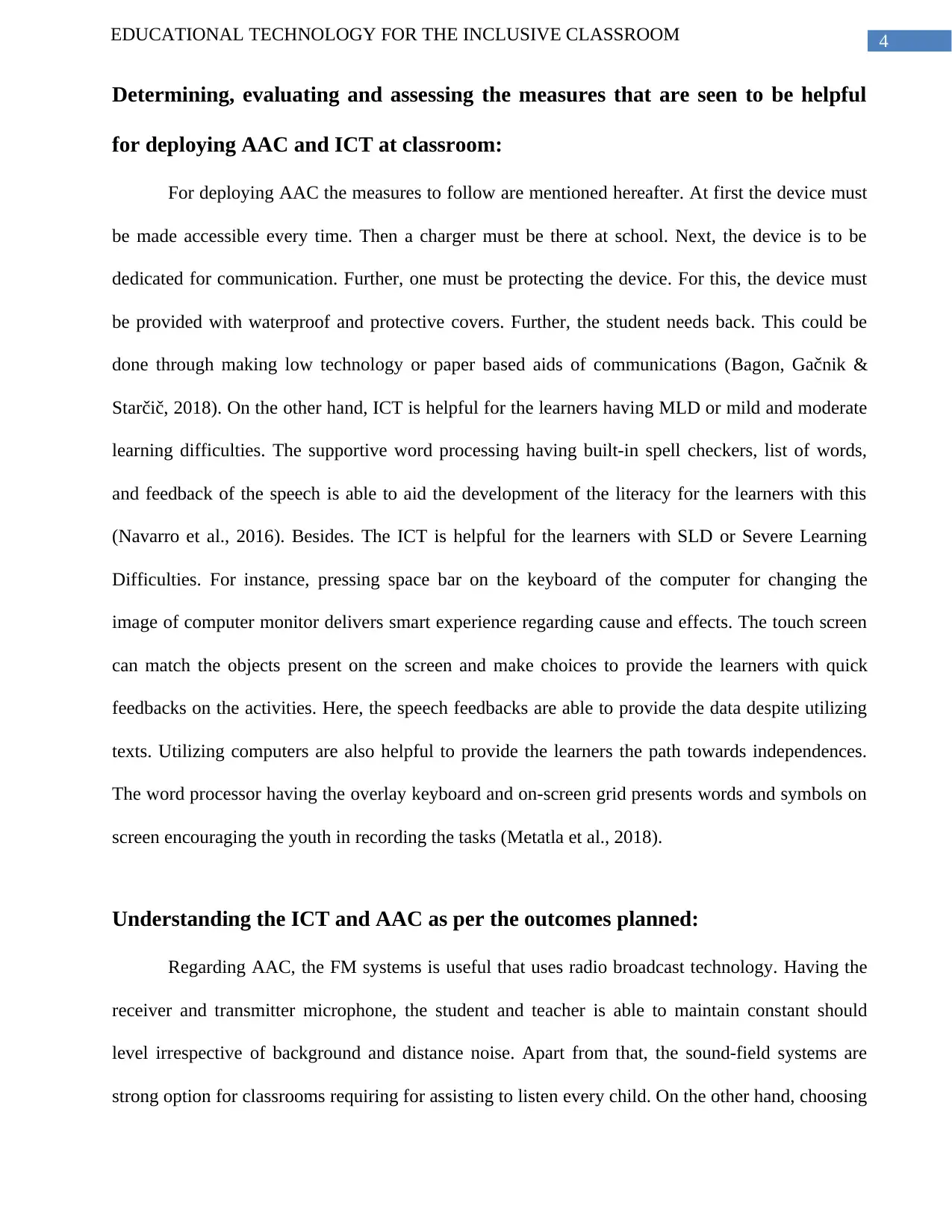
4EDUCATIONAL TECHNOLOGY FOR THE INCLUSIVE CLASSROOM
Determining, evaluating and assessing the measures that are seen to be helpful
for deploying AAC and ICT at classroom:
For deploying AAC the measures to follow are mentioned hereafter. At first the device must
be made accessible every time. Then a charger must be there at school. Next, the device is to be
dedicated for communication. Further, one must be protecting the device. For this, the device must
be provided with waterproof and protective covers. Further, the student needs back. This could be
done through making low technology or paper based aids of communications (Bagon, Gačnik &
Starčič, 2018). On the other hand, ICT is helpful for the learners having MLD or mild and moderate
learning difficulties. The supportive word processing having built-in spell checkers, list of words,
and feedback of the speech is able to aid the development of the literacy for the learners with this
(Navarro et al., 2016). Besides. The ICT is helpful for the learners with SLD or Severe Learning
Difficulties. For instance, pressing space bar on the keyboard of the computer for changing the
image of computer monitor delivers smart experience regarding cause and effects. The touch screen
can match the objects present on the screen and make choices to provide the learners with quick
feedbacks on the activities. Here, the speech feedbacks are able to provide the data despite utilizing
texts. Utilizing computers are also helpful to provide the learners the path towards independences.
The word processor having the overlay keyboard and on-screen grid presents words and symbols on
screen encouraging the youth in recording the tasks (Metatla et al., 2018).
Understanding the ICT and AAC as per the outcomes planned:
Regarding AAC, the FM systems is useful that uses radio broadcast technology. Having the
receiver and transmitter microphone, the student and teacher is able to maintain constant should
level irrespective of background and distance noise. Apart from that, the sound-field systems are
strong option for classrooms requiring for assisting to listen every child. On the other hand, choosing
Determining, evaluating and assessing the measures that are seen to be helpful
for deploying AAC and ICT at classroom:
For deploying AAC the measures to follow are mentioned hereafter. At first the device must
be made accessible every time. Then a charger must be there at school. Next, the device is to be
dedicated for communication. Further, one must be protecting the device. For this, the device must
be provided with waterproof and protective covers. Further, the student needs back. This could be
done through making low technology or paper based aids of communications (Bagon, Gačnik &
Starčič, 2018). On the other hand, ICT is helpful for the learners having MLD or mild and moderate
learning difficulties. The supportive word processing having built-in spell checkers, list of words,
and feedback of the speech is able to aid the development of the literacy for the learners with this
(Navarro et al., 2016). Besides. The ICT is helpful for the learners with SLD or Severe Learning
Difficulties. For instance, pressing space bar on the keyboard of the computer for changing the
image of computer monitor delivers smart experience regarding cause and effects. The touch screen
can match the objects present on the screen and make choices to provide the learners with quick
feedbacks on the activities. Here, the speech feedbacks are able to provide the data despite utilizing
texts. Utilizing computers are also helpful to provide the learners the path towards independences.
The word processor having the overlay keyboard and on-screen grid presents words and symbols on
screen encouraging the youth in recording the tasks (Metatla et al., 2018).
Understanding the ICT and AAC as per the outcomes planned:
Regarding AAC, the FM systems is useful that uses radio broadcast technology. Having the
receiver and transmitter microphone, the student and teacher is able to maintain constant should
level irrespective of background and distance noise. Apart from that, the sound-field systems are
strong option for classrooms requiring for assisting to listen every child. On the other hand, choosing
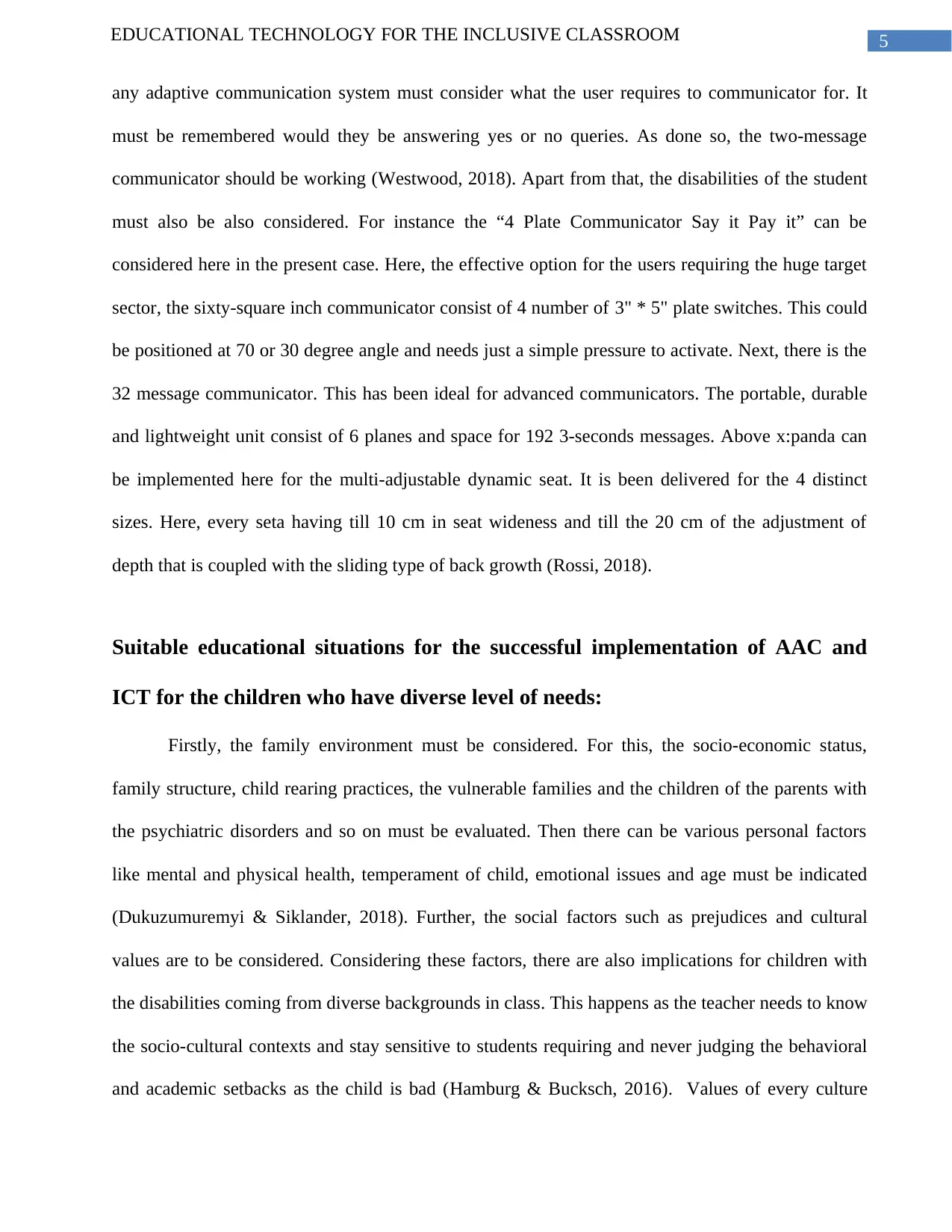
5EDUCATIONAL TECHNOLOGY FOR THE INCLUSIVE CLASSROOM
any adaptive communication system must consider what the user requires to communicator for. It
must be remembered would they be answering yes or no queries. As done so, the two-message
communicator should be working (Westwood, 2018). Apart from that, the disabilities of the student
must also be also considered. For instance the “4 Plate Communicator Say it Pay it” can be
considered here in the present case. Here, the effective option for the users requiring the huge target
sector, the sixty-square inch communicator consist of 4 number of 3" * 5" plate switches. This could
be positioned at 70 or 30 degree angle and needs just a simple pressure to activate. Next, there is the
32 message communicator. This has been ideal for advanced communicators. The portable, durable
and lightweight unit consist of 6 planes and space for 192 3-seconds messages. Above x:panda can
be implemented here for the multi-adjustable dynamic seat. It is been delivered for the 4 distinct
sizes. Here, every seta having till 10 cm in seat wideness and till the 20 cm of the adjustment of
depth that is coupled with the sliding type of back growth (Rossi, 2018).
Suitable educational situations for the successful implementation of AAC and
ICT for the children who have diverse level of needs:
Firstly, the family environment must be considered. For this, the socio-economic status,
family structure, child rearing practices, the vulnerable families and the children of the parents with
the psychiatric disorders and so on must be evaluated. Then there can be various personal factors
like mental and physical health, temperament of child, emotional issues and age must be indicated
(Dukuzumuremyi & Siklander, 2018). Further, the social factors such as prejudices and cultural
values are to be considered. Considering these factors, there are also implications for children with
the disabilities coming from diverse backgrounds in class. This happens as the teacher needs to know
the socio-cultural contexts and stay sensitive to students requiring and never judging the behavioral
and academic setbacks as the child is bad (Hamburg & Bucksch, 2016). Values of every culture
any adaptive communication system must consider what the user requires to communicator for. It
must be remembered would they be answering yes or no queries. As done so, the two-message
communicator should be working (Westwood, 2018). Apart from that, the disabilities of the student
must also be also considered. For instance the “4 Plate Communicator Say it Pay it” can be
considered here in the present case. Here, the effective option for the users requiring the huge target
sector, the sixty-square inch communicator consist of 4 number of 3" * 5" plate switches. This could
be positioned at 70 or 30 degree angle and needs just a simple pressure to activate. Next, there is the
32 message communicator. This has been ideal for advanced communicators. The portable, durable
and lightweight unit consist of 6 planes and space for 192 3-seconds messages. Above x:panda can
be implemented here for the multi-adjustable dynamic seat. It is been delivered for the 4 distinct
sizes. Here, every seta having till 10 cm in seat wideness and till the 20 cm of the adjustment of
depth that is coupled with the sliding type of back growth (Rossi, 2018).
Suitable educational situations for the successful implementation of AAC and
ICT for the children who have diverse level of needs:
Firstly, the family environment must be considered. For this, the socio-economic status,
family structure, child rearing practices, the vulnerable families and the children of the parents with
the psychiatric disorders and so on must be evaluated. Then there can be various personal factors
like mental and physical health, temperament of child, emotional issues and age must be indicated
(Dukuzumuremyi & Siklander, 2018). Further, the social factors such as prejudices and cultural
values are to be considered. Considering these factors, there are also implications for children with
the disabilities coming from diverse backgrounds in class. This happens as the teacher needs to know
the socio-cultural contexts and stay sensitive to students requiring and never judging the behavioral
and academic setbacks as the child is bad (Hamburg & Bucksch, 2016). Values of every culture
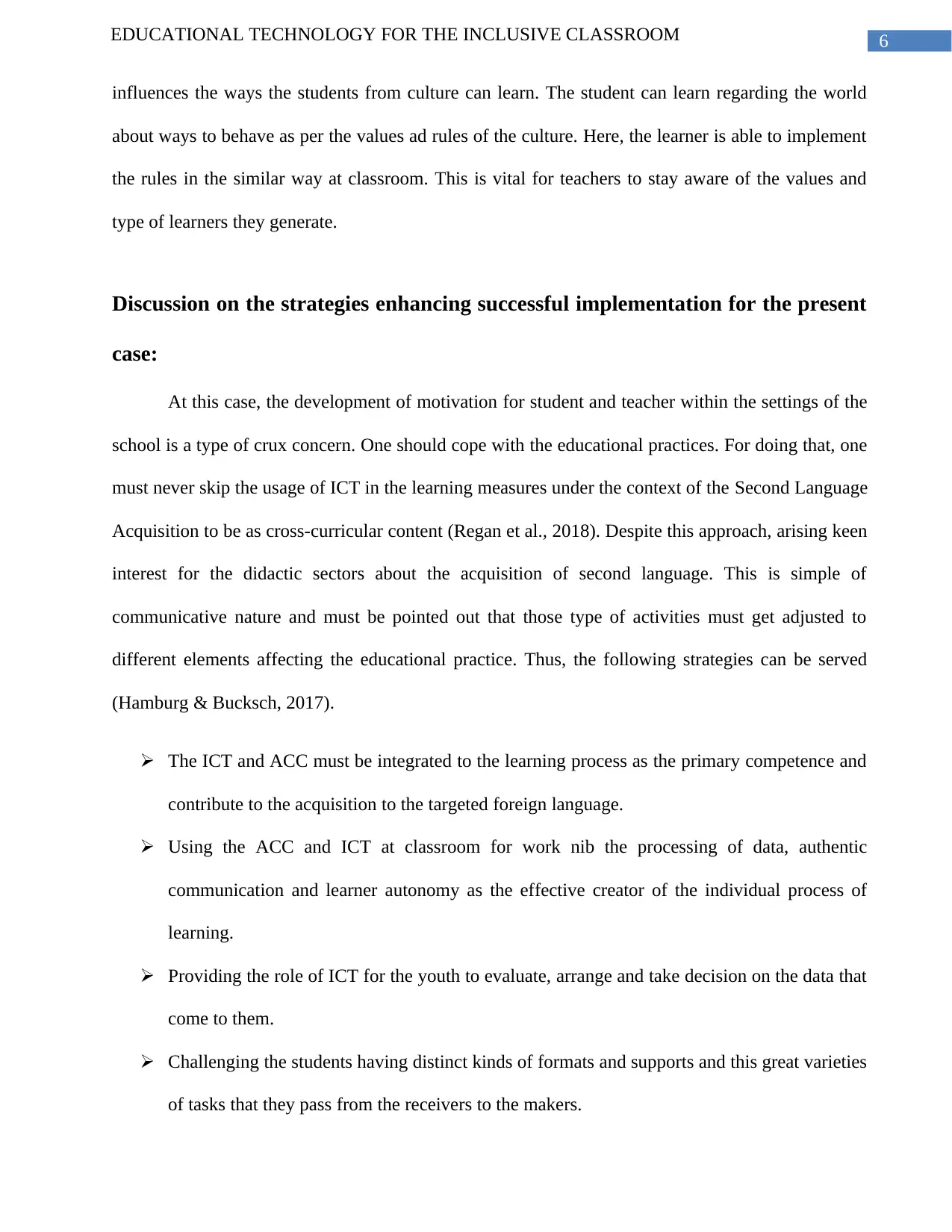
6EDUCATIONAL TECHNOLOGY FOR THE INCLUSIVE CLASSROOM
influences the ways the students from culture can learn. The student can learn regarding the world
about ways to behave as per the values ad rules of the culture. Here, the learner is able to implement
the rules in the similar way at classroom. This is vital for teachers to stay aware of the values and
type of learners they generate.
Discussion on the strategies enhancing successful implementation for the present
case:
At this case, the development of motivation for student and teacher within the settings of the
school is a type of crux concern. One should cope with the educational practices. For doing that, one
must never skip the usage of ICT in the learning measures under the context of the Second Language
Acquisition to be as cross-curricular content (Regan et al., 2018). Despite this approach, arising keen
interest for the didactic sectors about the acquisition of second language. This is simple of
communicative nature and must be pointed out that those type of activities must get adjusted to
different elements affecting the educational practice. Thus, the following strategies can be served
(Hamburg & Bucksch, 2017).
The ICT and ACC must be integrated to the learning process as the primary competence and
contribute to the acquisition to the targeted foreign language.
Using the ACC and ICT at classroom for work nib the processing of data, authentic
communication and learner autonomy as the effective creator of the individual process of
learning.
Providing the role of ICT for the youth to evaluate, arrange and take decision on the data that
come to them.
Challenging the students having distinct kinds of formats and supports and this great varieties
of tasks that they pass from the receivers to the makers.
influences the ways the students from culture can learn. The student can learn regarding the world
about ways to behave as per the values ad rules of the culture. Here, the learner is able to implement
the rules in the similar way at classroom. This is vital for teachers to stay aware of the values and
type of learners they generate.
Discussion on the strategies enhancing successful implementation for the present
case:
At this case, the development of motivation for student and teacher within the settings of the
school is a type of crux concern. One should cope with the educational practices. For doing that, one
must never skip the usage of ICT in the learning measures under the context of the Second Language
Acquisition to be as cross-curricular content (Regan et al., 2018). Despite this approach, arising keen
interest for the didactic sectors about the acquisition of second language. This is simple of
communicative nature and must be pointed out that those type of activities must get adjusted to
different elements affecting the educational practice. Thus, the following strategies can be served
(Hamburg & Bucksch, 2017).
The ICT and ACC must be integrated to the learning process as the primary competence and
contribute to the acquisition to the targeted foreign language.
Using the ACC and ICT at classroom for work nib the processing of data, authentic
communication and learner autonomy as the effective creator of the individual process of
learning.
Providing the role of ICT for the youth to evaluate, arrange and take decision on the data that
come to them.
Challenging the students having distinct kinds of formats and supports and this great varieties
of tasks that they pass from the receivers to the makers.
Paraphrase This Document
Need a fresh take? Get an instant paraphrase of this document with our AI Paraphraser
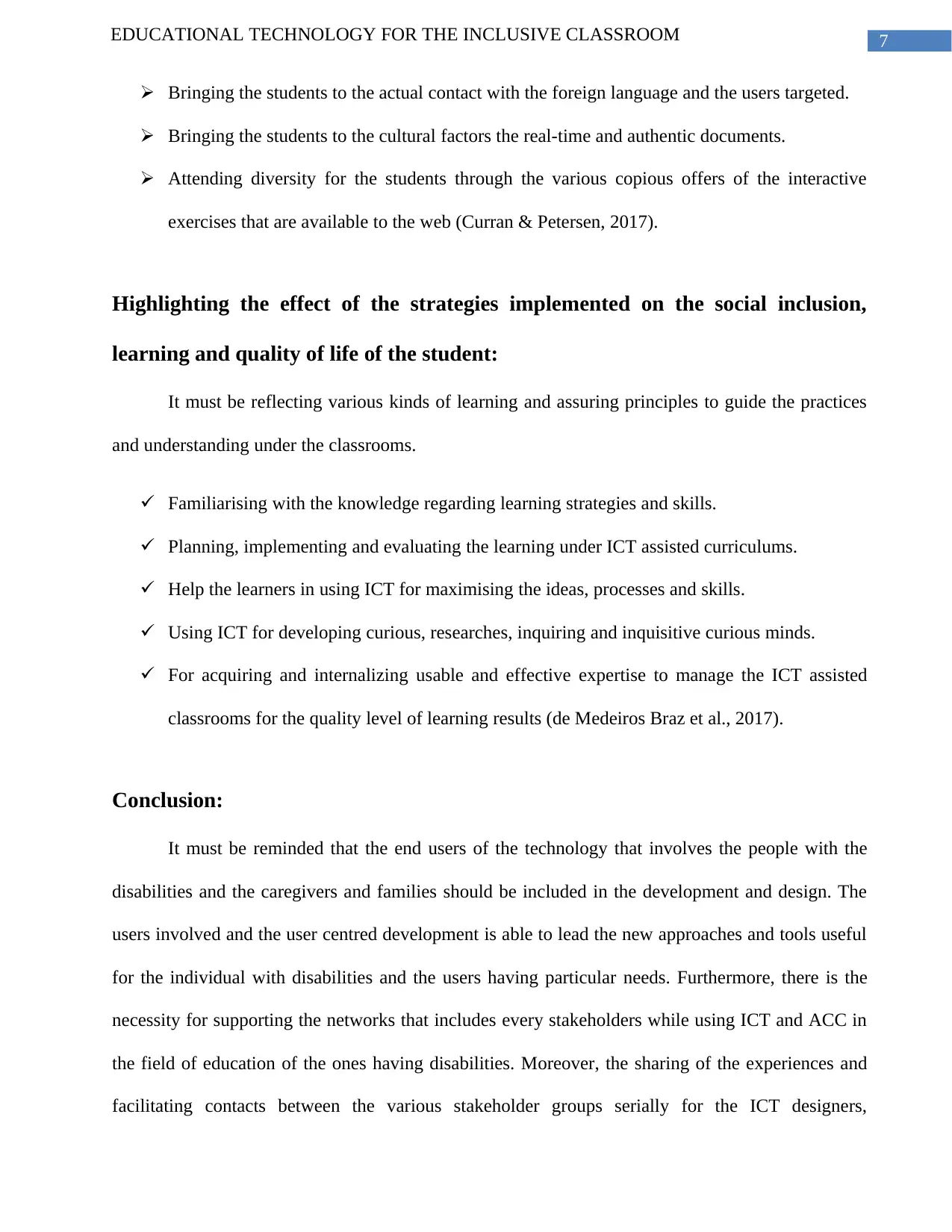
7EDUCATIONAL TECHNOLOGY FOR THE INCLUSIVE CLASSROOM
Bringing the students to the actual contact with the foreign language and the users targeted.
Bringing the students to the cultural factors the real-time and authentic documents.
Attending diversity for the students through the various copious offers of the interactive
exercises that are available to the web (Curran & Petersen, 2017).
Highlighting the effect of the strategies implemented on the social inclusion,
learning and quality of life of the student:
It must be reflecting various kinds of learning and assuring principles to guide the practices
and understanding under the classrooms.
Familiarising with the knowledge regarding learning strategies and skills.
Planning, implementing and evaluating the learning under ICT assisted curriculums.
Help the learners in using ICT for maximising the ideas, processes and skills.
Using ICT for developing curious, researches, inquiring and inquisitive curious minds.
For acquiring and internalizing usable and effective expertise to manage the ICT assisted
classrooms for the quality level of learning results (de Medeiros Braz et al., 2017).
Conclusion:
It must be reminded that the end users of the technology that involves the people with the
disabilities and the caregivers and families should be included in the development and design. The
users involved and the user centred development is able to lead the new approaches and tools useful
for the individual with disabilities and the users having particular needs. Furthermore, there is the
necessity for supporting the networks that includes every stakeholders while using ICT and ACC in
the field of education of the ones having disabilities. Moreover, the sharing of the experiences and
facilitating contacts between the various stakeholder groups serially for the ICT designers,
Bringing the students to the actual contact with the foreign language and the users targeted.
Bringing the students to the cultural factors the real-time and authentic documents.
Attending diversity for the students through the various copious offers of the interactive
exercises that are available to the web (Curran & Petersen, 2017).
Highlighting the effect of the strategies implemented on the social inclusion,
learning and quality of life of the student:
It must be reflecting various kinds of learning and assuring principles to guide the practices
and understanding under the classrooms.
Familiarising with the knowledge regarding learning strategies and skills.
Planning, implementing and evaluating the learning under ICT assisted curriculums.
Help the learners in using ICT for maximising the ideas, processes and skills.
Using ICT for developing curious, researches, inquiring and inquisitive curious minds.
For acquiring and internalizing usable and effective expertise to manage the ICT assisted
classrooms for the quality level of learning results (de Medeiros Braz et al., 2017).
Conclusion:
It must be reminded that the end users of the technology that involves the people with the
disabilities and the caregivers and families should be included in the development and design. The
users involved and the user centred development is able to lead the new approaches and tools useful
for the individual with disabilities and the users having particular needs. Furthermore, there is the
necessity for supporting the networks that includes every stakeholders while using ICT and ACC in
the field of education of the ones having disabilities. Moreover, the sharing of the experiences and
facilitating contacts between the various stakeholder groups serially for the ICT designers,
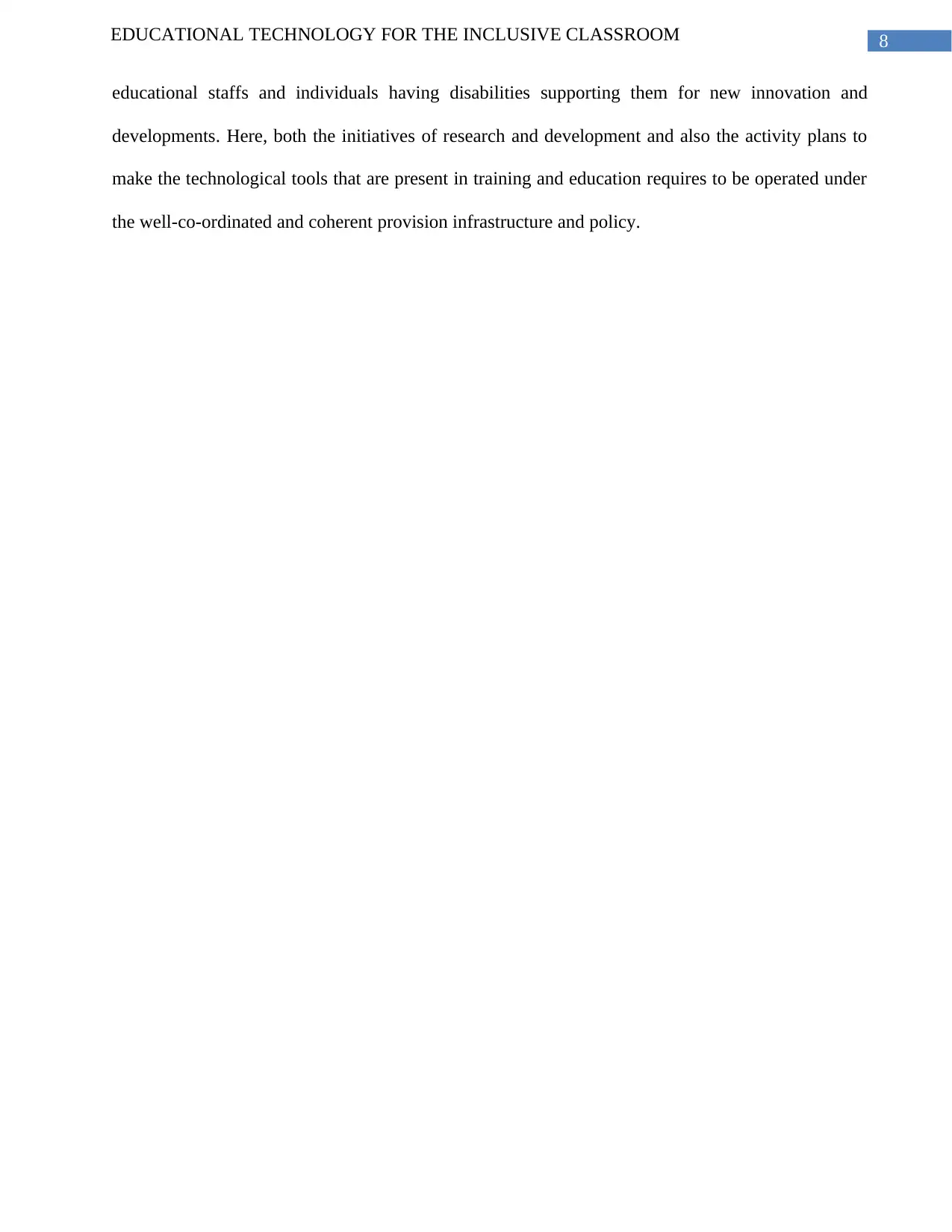
8EDUCATIONAL TECHNOLOGY FOR THE INCLUSIVE CLASSROOM
educational staffs and individuals having disabilities supporting them for new innovation and
developments. Here, both the initiatives of research and development and also the activity plans to
make the technological tools that are present in training and education requires to be operated under
the well-co-ordinated and coherent provision infrastructure and policy.
educational staffs and individuals having disabilities supporting them for new innovation and
developments. Here, both the initiatives of research and development and also the activity plans to
make the technological tools that are present in training and education requires to be operated under
the well-co-ordinated and coherent provision infrastructure and policy.
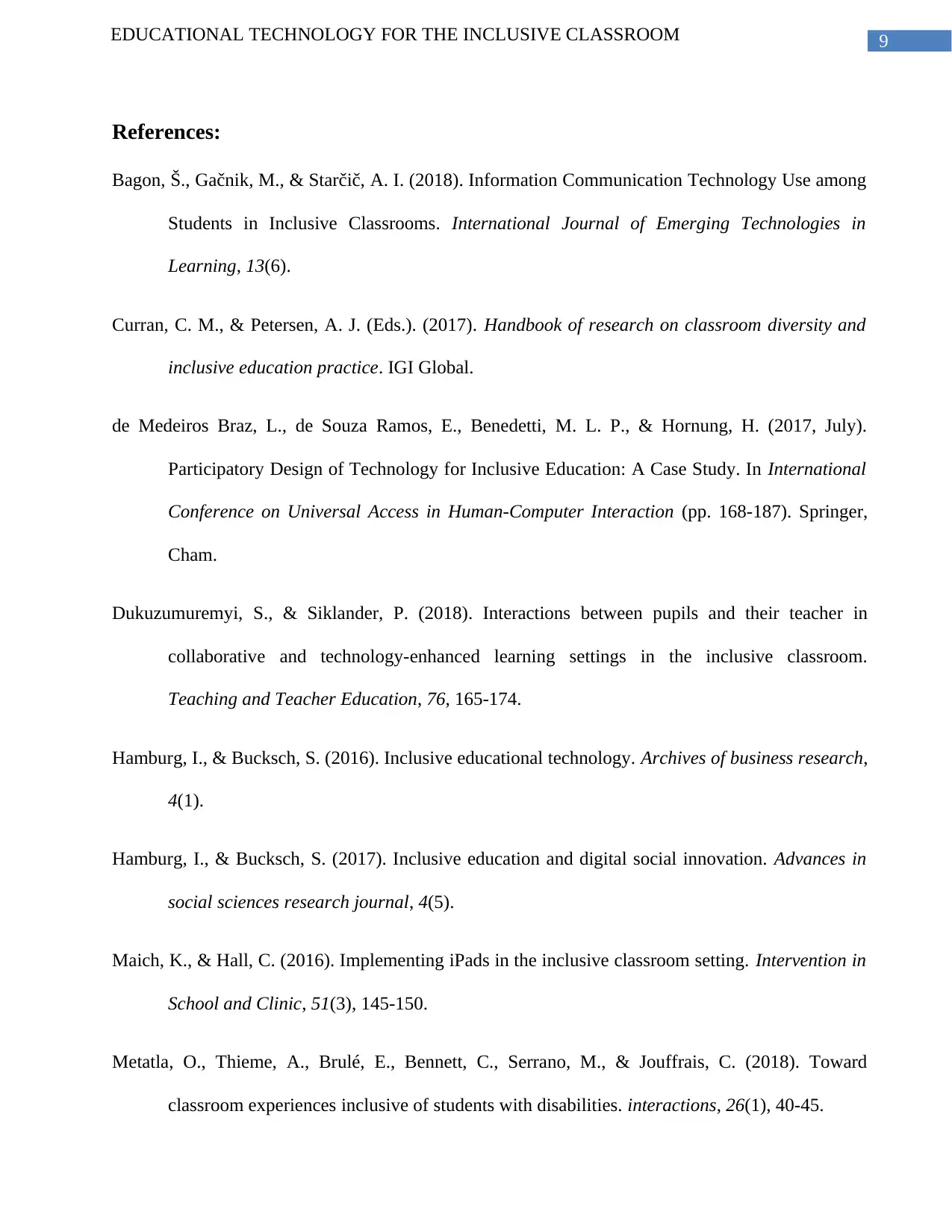
9EDUCATIONAL TECHNOLOGY FOR THE INCLUSIVE CLASSROOM
References:
Bagon, Š., Gačnik, M., & Starčič, A. I. (2018). Information Communication Technology Use among
Students in Inclusive Classrooms. International Journal of Emerging Technologies in
Learning, 13(6).
Curran, C. M., & Petersen, A. J. (Eds.). (2017). Handbook of research on classroom diversity and
inclusive education practice. IGI Global.
de Medeiros Braz, L., de Souza Ramos, E., Benedetti, M. L. P., & Hornung, H. (2017, July).
Participatory Design of Technology for Inclusive Education: A Case Study. In International
Conference on Universal Access in Human-Computer Interaction (pp. 168-187). Springer,
Cham.
Dukuzumuremyi, S., & Siklander, P. (2018). Interactions between pupils and their teacher in
collaborative and technology-enhanced learning settings in the inclusive classroom.
Teaching and Teacher Education, 76, 165-174.
Hamburg, I., & Bucksch, S. (2016). Inclusive educational technology. Archives of business research,
4(1).
Hamburg, I., & Bucksch, S. (2017). Inclusive education and digital social innovation. Advances in
social sciences research journal, 4(5).
Maich, K., & Hall, C. (2016). Implementing iPads in the inclusive classroom setting. Intervention in
School and Clinic, 51(3), 145-150.
Metatla, O., Thieme, A., Brulé, E., Bennett, C., Serrano, M., & Jouffrais, C. (2018). Toward
classroom experiences inclusive of students with disabilities. interactions, 26(1), 40-45.
References:
Bagon, Š., Gačnik, M., & Starčič, A. I. (2018). Information Communication Technology Use among
Students in Inclusive Classrooms. International Journal of Emerging Technologies in
Learning, 13(6).
Curran, C. M., & Petersen, A. J. (Eds.). (2017). Handbook of research on classroom diversity and
inclusive education practice. IGI Global.
de Medeiros Braz, L., de Souza Ramos, E., Benedetti, M. L. P., & Hornung, H. (2017, July).
Participatory Design of Technology for Inclusive Education: A Case Study. In International
Conference on Universal Access in Human-Computer Interaction (pp. 168-187). Springer,
Cham.
Dukuzumuremyi, S., & Siklander, P. (2018). Interactions between pupils and their teacher in
collaborative and technology-enhanced learning settings in the inclusive classroom.
Teaching and Teacher Education, 76, 165-174.
Hamburg, I., & Bucksch, S. (2016). Inclusive educational technology. Archives of business research,
4(1).
Hamburg, I., & Bucksch, S. (2017). Inclusive education and digital social innovation. Advances in
social sciences research journal, 4(5).
Maich, K., & Hall, C. (2016). Implementing iPads in the inclusive classroom setting. Intervention in
School and Clinic, 51(3), 145-150.
Metatla, O., Thieme, A., Brulé, E., Bennett, C., Serrano, M., & Jouffrais, C. (2018). Toward
classroom experiences inclusive of students with disabilities. interactions, 26(1), 40-45.
Secure Best Marks with AI Grader
Need help grading? Try our AI Grader for instant feedback on your assignments.
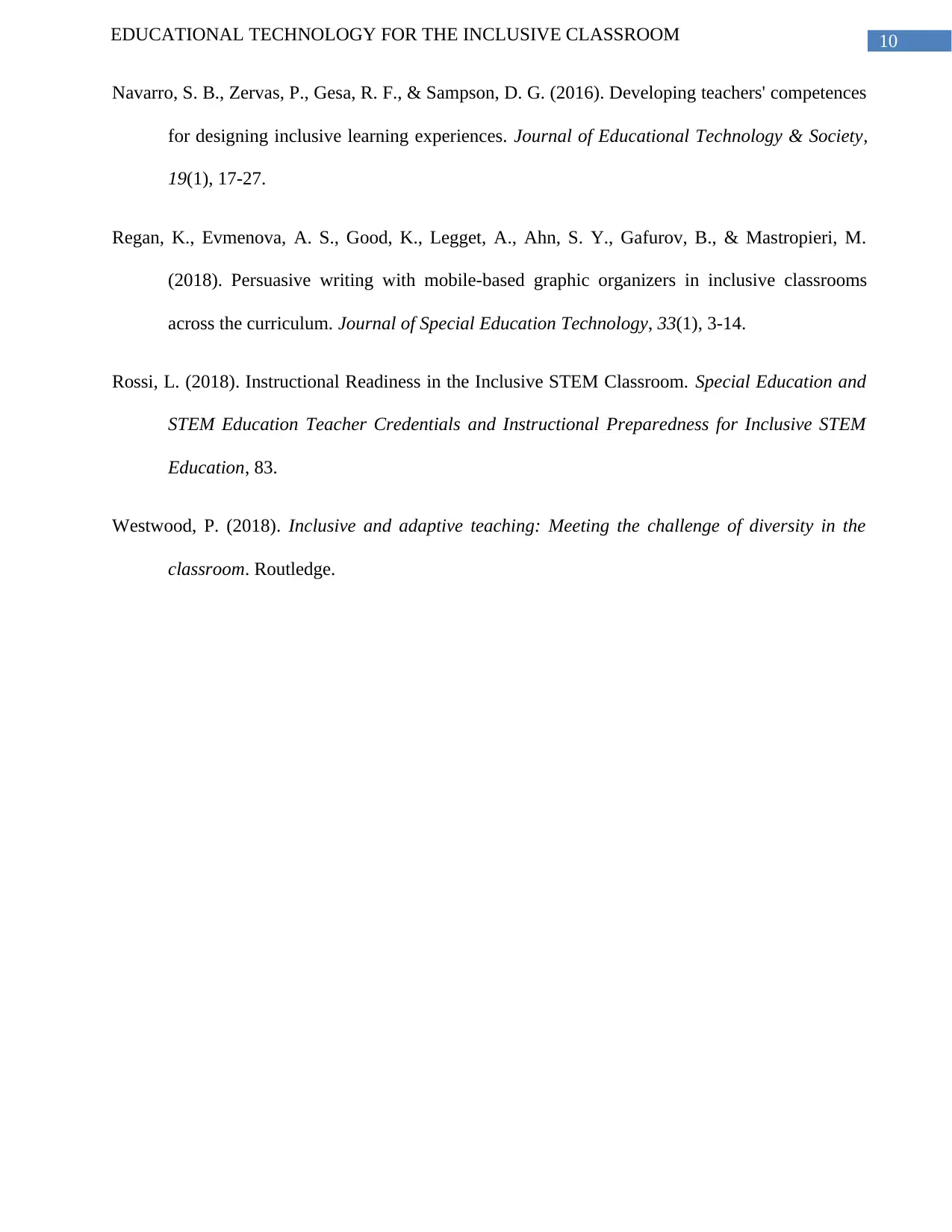
10EDUCATIONAL TECHNOLOGY FOR THE INCLUSIVE CLASSROOM
Navarro, S. B., Zervas, P., Gesa, R. F., & Sampson, D. G. (2016). Developing teachers' competences
for designing inclusive learning experiences. Journal of Educational Technology & Society,
19(1), 17-27.
Regan, K., Evmenova, A. S., Good, K., Legget, A., Ahn, S. Y., Gafurov, B., & Mastropieri, M.
(2018). Persuasive writing with mobile-based graphic organizers in inclusive classrooms
across the curriculum. Journal of Special Education Technology, 33(1), 3-14.
Rossi, L. (2018). Instructional Readiness in the Inclusive STEM Classroom. Special Education and
STEM Education Teacher Credentials and Instructional Preparedness for Inclusive STEM
Education, 83.
Westwood, P. (2018). Inclusive and adaptive teaching: Meeting the challenge of diversity in the
classroom. Routledge.
Navarro, S. B., Zervas, P., Gesa, R. F., & Sampson, D. G. (2016). Developing teachers' competences
for designing inclusive learning experiences. Journal of Educational Technology & Society,
19(1), 17-27.
Regan, K., Evmenova, A. S., Good, K., Legget, A., Ahn, S. Y., Gafurov, B., & Mastropieri, M.
(2018). Persuasive writing with mobile-based graphic organizers in inclusive classrooms
across the curriculum. Journal of Special Education Technology, 33(1), 3-14.
Rossi, L. (2018). Instructional Readiness in the Inclusive STEM Classroom. Special Education and
STEM Education Teacher Credentials and Instructional Preparedness for Inclusive STEM
Education, 83.
Westwood, P. (2018). Inclusive and adaptive teaching: Meeting the challenge of diversity in the
classroom. Routledge.
1 out of 11
Your All-in-One AI-Powered Toolkit for Academic Success.
+13062052269
info@desklib.com
Available 24*7 on WhatsApp / Email
![[object Object]](/_next/static/media/star-bottom.7253800d.svg)
Unlock your academic potential
© 2024 | Zucol Services PVT LTD | All rights reserved.


